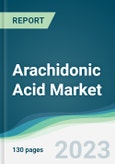The global arachidonic acid market is estimated to grow at a CAGR of 5.15% during the forecast period.
Arachidonic is a fatty acid that helps in a baby's developing brain. Arachidonic acid (ARA) is a crucial aspect of biological cell membranes because it gives them the fluidity and flexibility necessary for all cells to function properly, especially those in the immune system, skeletal muscle, and neurological systems. It comes from food or linoleic acid undergoing de-saturation and chain elongation. Ion channels, receptors, and enzymes are all affected by free ARA's ability to both activate and inhibit them.
One of the important Omega-6 fatty acids is arachidonic acid. It is regarded as an essential acid because it is kept inside cell membranes and guides signals of regenerative changes in response to damaging events. A separate intake of arachidonic acid in injections, syrups, or pills is required due to the body's lack of natural arachidonic acid. The main ingredients used to make ARA are, among others, maize, glucose, soy, and yeast.
There is a rising demand for ARA in dietary supplements as consumers become more health conscious. The probability of physical injuries is anticipated to rise with the popularity of outdoor athletic events like car racing and marathons, which are projected to drive the market in terms of rising application rates and generating revenue. Infant feeding formula penetration is rising, and sports nutrition is also being used more frequently, contributing to the market's expansion.
Increased use of arachidonic acid in infant formula
The fast technical improvements and new patents filed by the major market players will likely lead to a rise in the use of arachidonic acid in baby feeding during the forecast period. Babies require omega-6 fatty acids since they cannot synthesize the necessary quantity. As a result, the inclusion of ARA in baby food serves to supply the required fatty acids. The main elements that aid in synthesizing cell membranes in developing infants' brains are DHA and arachidonic acid (ARA), a 20-carbon fatty acid. Depending on a mother's diet, the amount of DHA and ARA in breast milk varies greatly between nations.
Athletics is a key area for the growing demand for ARA.
Arachidonic acid is growing rapidly in the world of athletics. Research on ARA supplements has also been conducted in neurology, hepatology, cardiology, and nutrition. Arachidonic acid regulates inflammation, although there are concerns regarding the risks associated with these supplements. The lean BMI, overall strength, and peak power of trained men may all be improved with ARA supplementation.
Utilization of ARA- rich oils is a significant demand driver.The use of ARA-rich oils obtained from the fungus Mortierella Alpina is well known, and the ingredient has long been used in infants and subsequent formulae. According to EU law, oil extracted from Mortierella Alpina is now allowed in infant formula, follow-on formula, and meals for medical purposes for newborns. The German company BASF and the Chinese company Hubei Fuxing Biotechnology are the leading firms producing ARA-rich oils from the fungus Mortierella Alpina.
North America is projected to be the prominent market throughout the forecast period.
North America is anticipated to be the largest market for arachidonic acid in food applications, second in Europe and Asia Pacific. The regulatory environment in the EU has helped the local market expand. The demand for ARA in infant formula is growing due to the presence of numerous companies, the intense R&D activities carried out with numerous new patents using ARA for infant formula, as well as sports nutrition, and the rising fertility rate in North America, particularly in Mexico. The current trend of utilizing ARA to treat diabetes is anticipated to aid in expanding the market in additional North American nations.
Market Developments:
- In October 2022,the CABIO R&D Centre investment project started in Wuhan Optical Valley. The Wuhan Synthetic Biology Innovation Centre project was launched based on the aforementioned investment initiative, a collaboration between CABIO Biotech (Wuhan) and Hubei Yangtze Science Innovation Service.
- In July 2022,Continental Grain and Cargill bought Sanderson Farms. Both have merged Sanderson Farms and Wayne Farms as part of the transaction to launch a new chicken company.
Market Segmentation:
By Source
- Animal
- Plant
By Form
- Dry
- Liquid
By Application
- Food and Beverage
- Infant Formula
- Dietary Supplements
- Pharmaceuticals
By Geography
- North America
- United States
- Canada
- Mexico
- South America
- Brazil
- Argentina
- Others
- Europe
- United Kingdom
- Germany
- France
- Spain
- Others
- Middle East and Africa
- Saudi Arabia
- UAE
- Israel
- Others
- Asia Pacific
- Japan
- China
- India
- South Korea
- Indonesia
- Thailand
- Others
Table of Contents
Companies Mentioned
- Cargill. Inc
- Cabio Biotech (Wuhan)Co., Ltd
- Cayman Chemicals
- Koninklijke DSM N.V.
- Merck Group
- Suntory Beverage & Food Ltd.
- Cayman Chemical Company
- Avanti Polar Lipids, Inc.
Methodology

LOADING...








